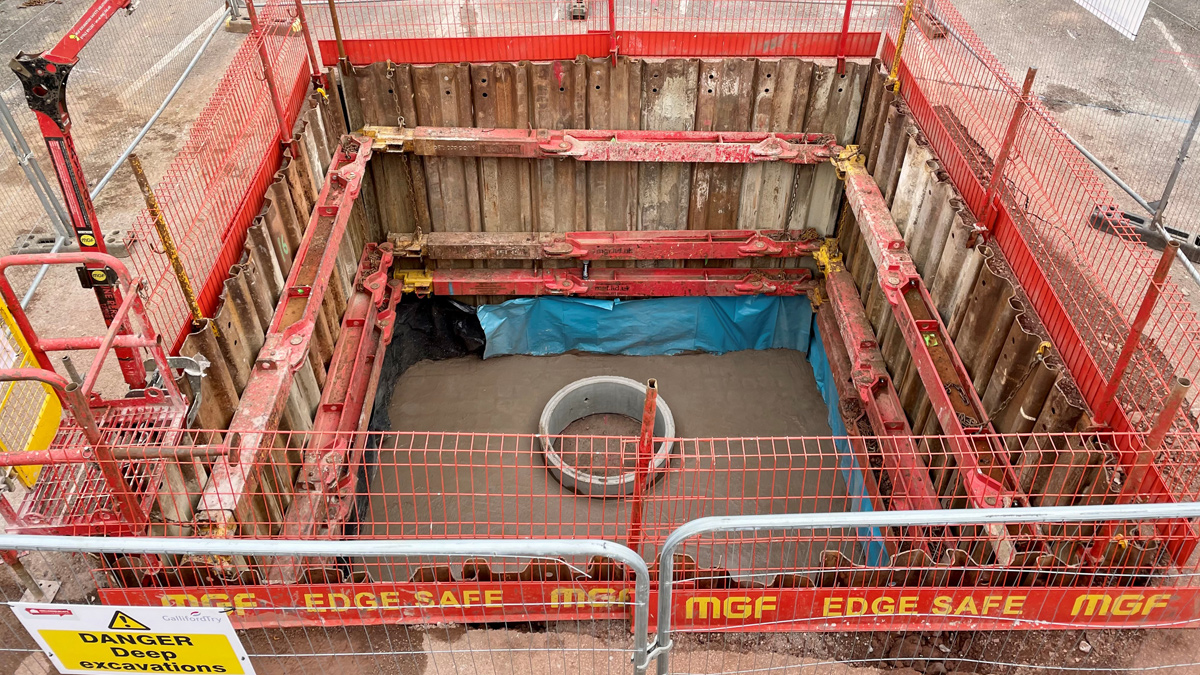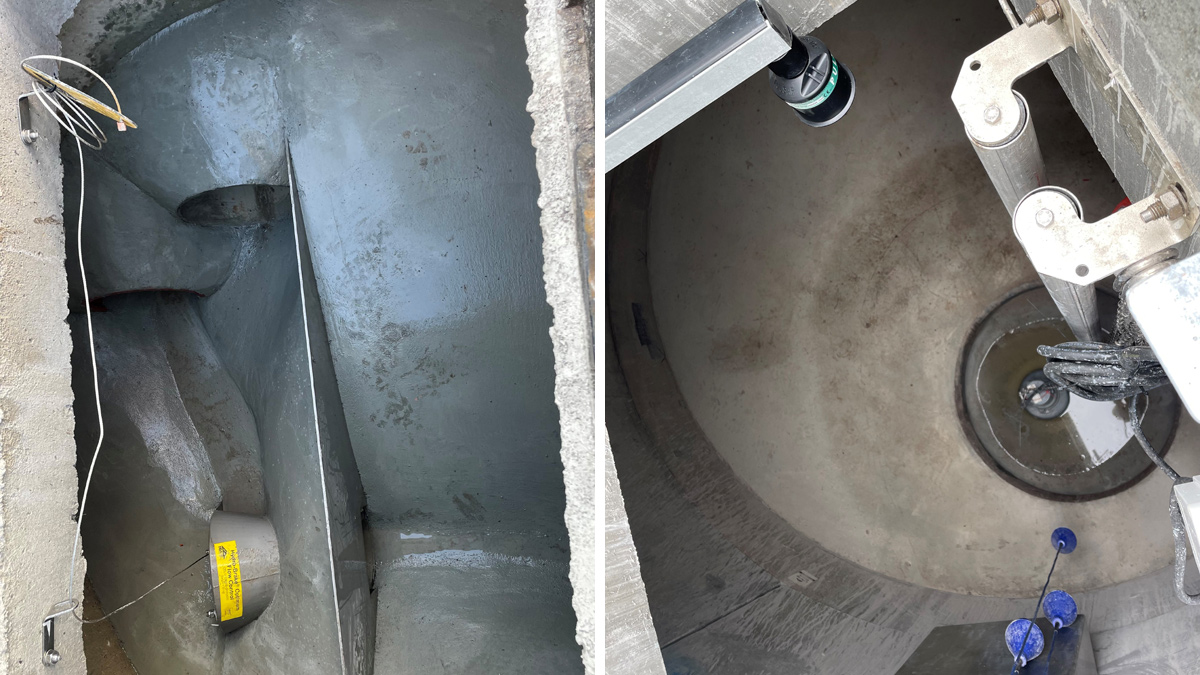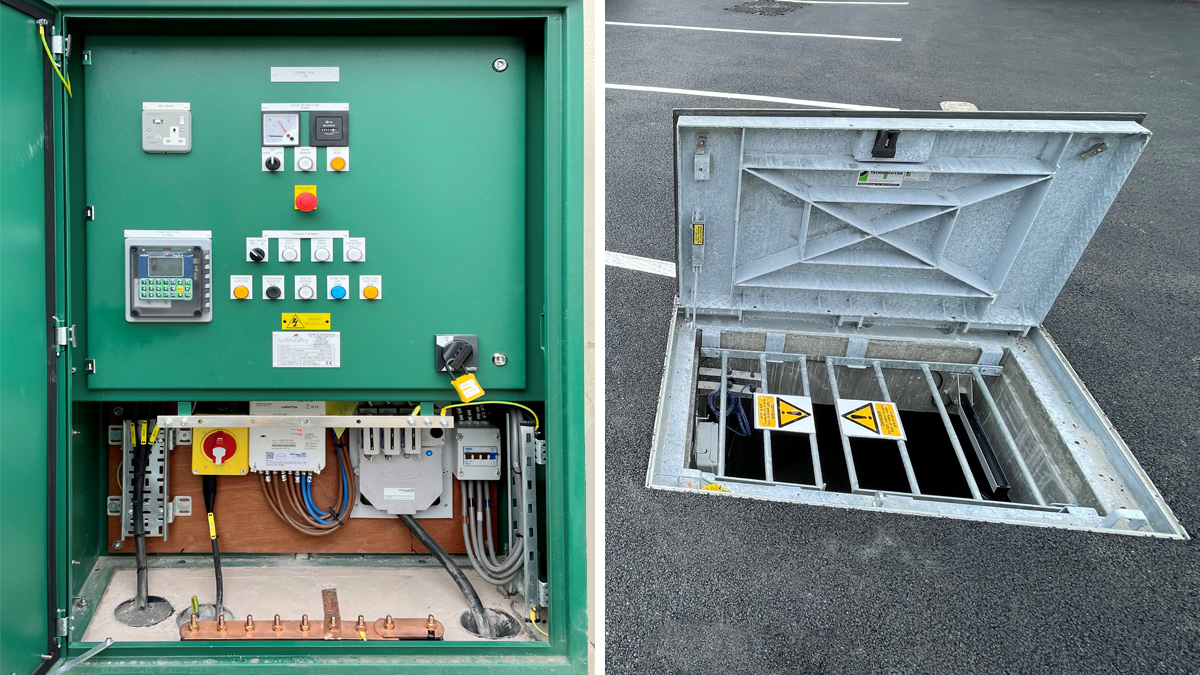Brook Street (Dawlish) CSO (2023)

Sheeted 5m x 5m x 5m cofferdam with base slab pored - Courtesy of Galliford Try
Dawlish is a traditional seaside town on the south coast of Devon, approximately 12 miles south of Exeter and is a popular holiday and day trip destination. South West Water (SWW) and Galliford Try’s objective was to ensure that the bathing water quality did not deteriorate within the next 20 years by ensuring that there are no more than two significant (>50m3) spills from the Brook Street CSO per bathing season by 31 March 2022. The proposed solution was to be achieved by providing 30m3 of offline, pumped return stormwater storage in the Manor House council office car park on Brook Street to improve spill performance at Meadow Road CSO in line with SWW/Environment Agency targets, in combination with the removal of surface water from the combined system; being delivered as a separate element of the overall project by another delivery partner.
Description
As part of the overall SWW objective to achieve less than two significant spills from Brook Street CSO per bathing water season, this project supplemented the scope from the infra delivery partner.
- Provision of 30m3 of unscreened, stormwater storage upstream of the Brook Street CSO, by the installation of a 4m diameter x 3m deep tank with duty pump return.
- Provide a flow control device (Hydro-Brake®) to limit PFF to 10 l/s with an unrestricted bypass arrangement within an overflow chamber.
- Once the tank is full, additional flow will bypass the Hydro-Brake® via a high-level weir.
- The agreed storage tank volume, flow control device and overflow weir levels have been derived from the Stantec UK modelling report and taken as the scheme output for the storage element. The final tank volume selection/spill performance of the promoted option has been selected at SWW IPC and has been operationally reviewed by SWW operations team, commissioning engineer and asset management.

(left) Flow control chamber showing overflow weir and Hydro-Brake® and (right) looking down into the 30m3 stormwater tank showing the float controls, pump, pump guides and sump – Courtesy of Galliford Try
Project scope
- Site mobilisation and temporary works, to include road closure of Brook Street and suitable traffic management/diversion.
- Construct 4m diameter x 3m deep (internal) PCC shaft in Brook House car park.
- Construct 30m of connecting pipework and associated manholes to connect new tank to existing sewerage network.
- Construct PCC overflow chamber to include Hydro-Brake®, spill weir and bypass weir.
- Install new single 5 l/s return pump and associated control cabinet, cabling, ducting, instrumentation and return rising main.
- Site reinstatement.
In-house capability
Galliford Try self-delivered this project, designing all civils and MEICA elements, as well as being the principal contractor and lead designer on the scheme. Galliford Try managed the site, direct labour, installation and commissioning, all within an incredibly tight programme (made tighter by severe storms).
Brook Street CSO: Supply chain – key participants
- Design & construction: Galliford Try
- Modelling: Stantec UK
- Shoring/temporary works: MGF Ltd
- Hydro-Brake®: Hydro International (UK) Ltd
- Pumps: Xylem Water Solutions
- Access covers: Technocover Ltd
- Traffic Management: Amberon Ltd
- Fabrications: Thorne Fabrication Limited
- Electrical items: Edmundson Electrical Ltd
- Diamond drilling works: 24-7 Diamond Drilling & Sawing Services Ltd
- Civils items: Keyline Civils Specialist
- Plant hire: Gap Group Ltd
- Aggregates: Hanson Aggregates
- Construction Products: Jewson
- Plant hire: Plantforce Rentals Ltd
- Crane hire: Spence Crane Hire Ltd
- Tarmac surfacing: Devon Tarmasters
Planning & collaboration
The site footprint consisted of a small section of The Manor House carpark (which belongs to the Dawlish Council offices), a 20m x 20m area in which Galliford Try managed to contain their welfare facilities and site office, working area and laydown of plant, equipment and materials, a 5.5m diameter, 5m deep shaft and two flow controlling combined sewer inspection chambers with a pumped return, MCC cabinet, two weirs and a Hydro-Brake®.
Galliford Try also had to construct two inlet and outlet inspection chambers within a very tight street with multiple existing services. They accomplished this using road closure notices and daily communication with the residents of the local area.
During the works, Galliford Try had to excavate the shaft using a 14t wheeled excavator, an MGF TWD of sheets and frames, 5m away from a listed building. SWW estates team carried out a structural survey on the building before they started, and no evidence of any movement was detected associated with the works. Galliford Try mucked away 225t of spoil from the shaft while working closely with another SWW contractor during the construction phase to reduce their footprint further, they arranged joint use of their muck away process meaning reduced footprint of their working area and around half the amount of muck wagons going through Dawlish town centre. Galliford Try also required a 40t mobile crane to lift in the large pre-cast concrete shaft section which required an intricate lift plan and careful logistics.
To connect the stormwater storage tank and flow control inspection chambers into the existing network Galliford Try had to accurately survey the existing sewer and optimise the inlet point inspection chamber missing two water mains, a gas main and a surface water drain. To return the flows to the existing sewer they had to precisely know at which point their tank would spill to contain the required volume of storage. The existing sewers in Brook Street were incredibly old and fragile, they had to delicately expose the existing sewer and break in without cracking the upstream and downstream section of pipework. Galliford Try managed to install the chambers using the minimum amount of new pipework.

(left) All weather kiosk constructed off-site, containing the alarms, telemetry, pump return and mains in-comer and (right) access cover within the Manor House Car Park into the 30m3 stormwater tank all completed day before handover – Courtesy of Galliford Try
Off-site build
- All four new inspection chambers were concreted from PCC sections and all sections of the shaft were also PCC, reducing installation time and costs.
- The kiosk was constructed off-site by Galliford Try and installed by their panel shop and then commissioned three days before the commissioning, date reducing storage and on-site presence.
Challenges & risks
Galliford Try used a vacuum excavator (the fastest and most economical method of excavation) to dig around existing services. Benefits include: reducing reinstatement costs, eliminating the hazard of utility strikes, and reducing the amount of manpower/equipment required. The construction challenges:
- Small footprint/working area.
- Existing services in road.
- Managing access for stakeholders.
- Temporary works – excavating deep shaft adjacent to existing buildings.
Completion & carbon savings
Galliford Try completed this work following on from a previous project to remove the surface water run-off from the local catchment; greatly reducing the combined sewer flow rate and reduced the time the storm tank would fill, further reducing the risk of a spill during the bathing water season.
The overall scheme (including the surface water separation) would at some point become carbon negative, due to reducing the combined sewer flow to the local STW and not paying the energy bill to treat the additional storm flow now going straight into the Brook. This reduces the amount of flow being stored and pumped back into the combined sewer on time.

Completed car park area day before handback – Courtesy of Galliford Try
Community
Whilst road closures were in place, Galliford Try helped residents by assisting with taking their bins out to the new temporary location, as well as helping the older residents bring their shopping in.






